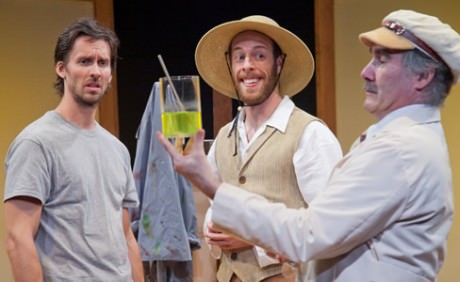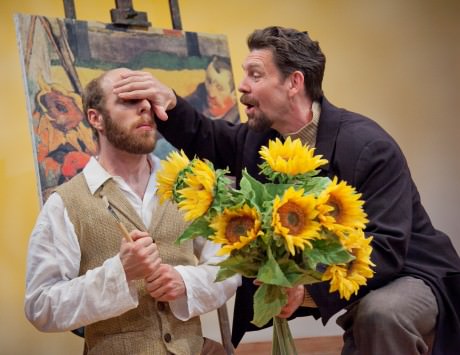Steven Dietz has the dubious distinction of being one of the nation’s most performed but least known playwrights. With its earnest production of Dietz’s searing, cerebral and enigmatic (and, some might say, problematic) Inventing Van Gogh, the Washington Stage Guild will probably do little to change that equation; there were but a baker’s dozen in the audience Saturday afternoon, few of whom probably left the theater thinking, “Yup. I know just how he/she/they felt.” That said, for anyone with an appetite for academic prolixity, armchair psychology and speed-dial art history—and an interest in the ways in which the links between art, fame, and commerce can strangle as often as they bond; and those that bind love, passion, and sex can do the same—this is certainly a play worth seeing.

Inventing Van Gogh posits the meeting of the spirit of the Dutch master, portrayed as being at turns confident, combative, uncertain, relentlessly determined and inconsolably depressed, and an impecunious young American painter of the present whose only interest in him is financial. As the play opens, the set is spare; two large white floor-to-ceiling screens framed in pale wood and slightly angled dominate the upstage. All is of wood: a pine bench at stage right, next to it a cherrywood easel, a bucket with a paint-stained white cloth hanging from it. As the audience settles into their seats, the lights dim, almost imperceptibly at first, as the easel slowly becomes illuminated. Suddenly: Blackout.
The lights come up to reveal two men. (The lighting, by Marianne Meadows, is superbly done throughout, illuminating faces and set pieces with intent and intelligence). One, a slim, mustachioed, mildly disheveled, dark-haired thirty-something in paint-streaked pale blue denim flyaway shirt, is at work at the easel. The other, sixtyish, grey-haired, more datedly formal in both dress and manner, addresses the audience.
He is Dr. Paul Gachet (Lawrence Redmond), Van Gogh’s physician, who tells us with restraint that the funeral of Vincent Willem Van Gogh, denied services by the church as a suicide, was held at the Auberge Ravoux in Auvers-sur-Oise, attended by friends, family and notables. “All is yellow,” he tells us, his stoic reserve beginning to falter. “Yellow flowers everywhere.” Redmond’s portrayal will be an anchor, a source of assurance in what will become a tumultuous tale.
One of the fundamental challenges of Inventing Van Gogh, for both actors and audiences, is that six of its eight characters are played by three actors who must, sometimes with barely enough time for a quick costume change, go in one era and out another. The exceptions are the two leads: Ryan Tumulty as Van Gogh, and Christopher Herring as Patrick Stone, a young painter with youth’s de rigueur disdain for the accepted and respected in a field where he feels he’s learned enough, and thus earned the right, to be coolly, even cruelly dismissive. Van Gogh? “A fraud,” whose colorful, tragic life is irresistible to the susceptible. In sum: “Nothing but hype.”
Patrick is approached by René Bouchard (Brit Herring, who, as far as I know, is not related to Christopher), an unscrupulous art authenticator who offers the young man a deal he is sure he cannot refuse: paint a forgery of the Holy Grail of Van Gogh-dom, the artist’s almost mythical last self-portrait that was never found, and take a cut of what is anticipated to be a stratospheric auction price. What makes René’s offer even more execrable is that Patrick has a history with the artist, one that makes him, in addition to his critical disdain, loath to touch even the thought of him with the tip of a brush: his professor and mentor, Dr. Jonas Miller (also Redmond), was obsessed with the artist’s last painting, “Wheatfield with Crows,” an obsession that would drive him to his death.
René, whose casually demeaning, smoothly menacing “offer” is a double-edged sword, tells Patrick that his professor’s suicide—near the site of Van Gogh’s own, a century before—is being investigated as suspicious, possibly murder. And that Patrick, whose own work is so little known and appreciated that he could fall off the map and not leave so much as a pinprick on it, therefore, clearly, has nothing to lose. Herring’s René is smarmily hateful here, a villain with no visible redeeming qualities.
As if that weren’t enough, Miller’s sharp-tongued, rough-edged (and maybe even psychologically unbalanced) daughter Hallie was once Patrick’s girlfriend; it didn’t end well. Nor, we learn, did Van Gogh’s unconsummated devotion to the gentle Marguerite Gachet, his doctor’s daughter. Two more different personalities could hardly be conceived, and both are consummately played by Jessica Shearer. (And consummately costumed by Lynn Steinmetz, whose flowing fabrics, Victorian cuts, delicate pastels and long blond curling tresses for Marguerite and butch pants, cropped dark hair and leather jacket for Hallie are a standout).
Ryan Tumulty, pale, tall and rangy, may not be the physical embodiment of the five-foot seven-inch Van Gogh, but he gives the character the near-manic intensity we’ve come to associate with the tormented painter. He also movingly conveys the artist’s passion for Marguerite in a scene that exemplifies Director Steven Carpenter’s skill in bringing emotion almost palpably to life, as Van Gogh hungrily caresses and strokes her arced body, lightly clothed in a white muslin gown that brushes the floor, with long-fingered hands that become imaginary brushes, the agony of the unreachable and unattainable a metaphor for the doomed sense of failure that suffuses him.
Tumulty is also effective in conveying Van Gogh’s uncompromising beliefs about what art is and what it should do, which he articulates forcefully and, when challenged, vociferously, both to Patrick—who, having come to terms with being haunted either figuratively or literally by his nemesis, takes him on, mano-a-mano—and to his onetime friend and roommate in the Yellow House, Paul Gauguin (Brit Herring).
A fellow depressive, Gauguin’s disillusionment with Impressionism spawns some violent arguments with Van Gogh, which the two actors bring off with biting vigor. Playing two unsympathetic characters, Gauguin and Bouchard, Herring may have either the best or the worst of the roles. On the surface, both are great to sink an actor’s teeth into, and Herring does that with relish. For this writer, though, at least on first viewing, the two do not have sufficient specificity, in either costume or speech pattern, to be easily distinguished.
And that is one of the challenges, or exciting elements—depending on the capacity of one’s brain to follow several fairly complex story lines occurring on parallel tracks in two centuries, with actors doubling roles—of the play. Watching them switch in and out of roles, times and places with no warning makes for an intriguing mental cat-and-mouse game. That is, until characters from one era pop in on the other. Then—on at least one occasion for this writer—all bets are off.
The use of narrators both helps and hinders. These short citations from the characters’ own letters are usually addressed to the audience downstage, alternately by Dr. Miller and Dr. Gachet (both Lawrence Redmond). Sometimes these help set the scene; at others, read so quickly we can barely integrate them into what we’ve seen or will see, they become tantalizingly frustrating glimpses into lives and events which, as in a docudrama, are essentially grounded in history, but creatively re-imagined.
The large canvases that fill the stage, facing backward when not apposite to the scene, sometimes brought out or spun around by one of the characters to illustrate a point, are also, for the average person, tantalizingly frustrating. It would no doubt be a treat to go with someone who knows his Van Gogh.
Dietz’s play is brimming with passion and intellect, arguably an exercise in literary Post-Impressionism with its bold emotional brushstrokes and its jump-cut time, place and character changes. Yet it also harks back to the concepts of Neo-Classicism with its use of downstage narrators bridging or amplifying the action we see with citations from the characters’ letters. If Inventing Van Gogh is not always fully realized, it is perhaps because there is simply too much information to be taken in at once. Like a painting, it may be best appreciated if seen again, with more revealed at each viewing.

A postscript: Just seven weeks ago, what is believed to be Van Gogh’s last painting was “publicly unveiled,” according to Wikipedia, “After it was retrieved from the attic of a Norwegian collector who misjudged the work as a fraud following its purchase in 1908. Sunset at Montmajour is a large oil landscape painting and, as of September 24, 2013, is displayed at Amsterdam’s Van Gogh Museum.”
Running Time: One hour and 55 minutes, with one intermission.
Inventing Van Gogh plays through November 24, 2013 at Washington Stage Guild at The Undercroft Theatre – 900 Massachusetts Avenue, NW in Washington, DC. For tickets, call (240) 582-0050, or purchase them online.




